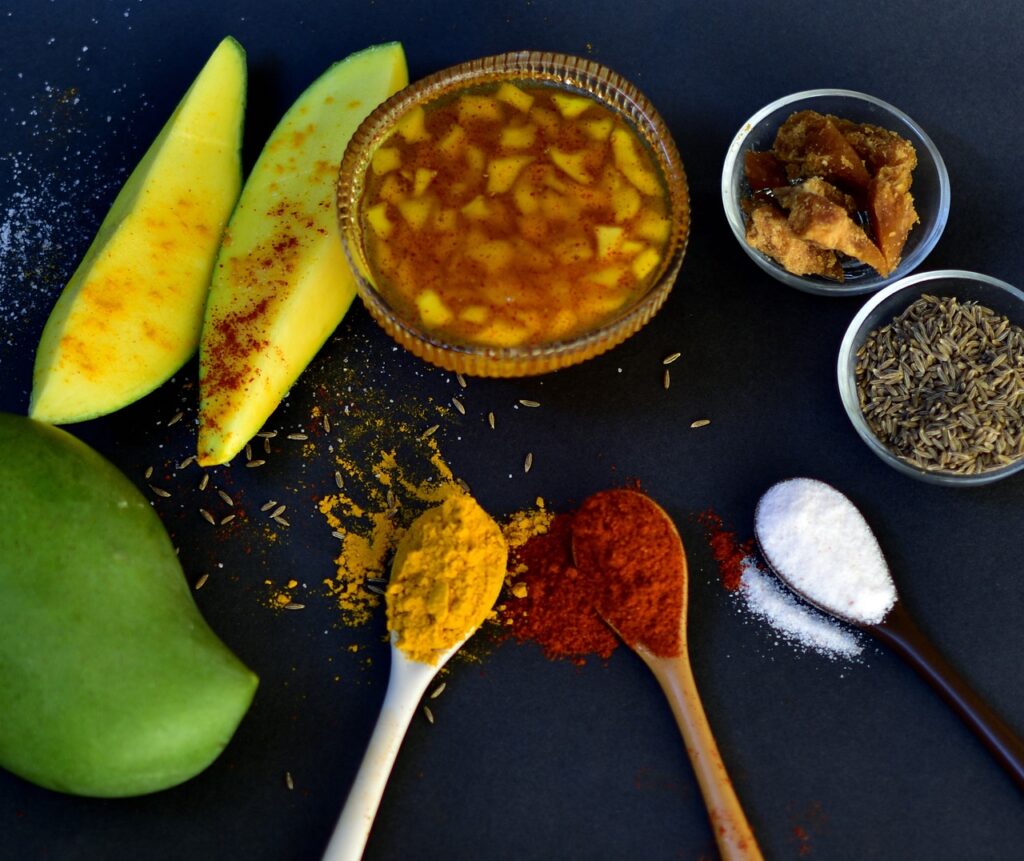Meta Description:
Discover the traditional Andhra mango pickle recipe (Avakaya) with step-by-step instructions, tips, ingredients, and secrets. 100% authentic, spicy, and lip-smacking—learn to make it at home like a pro!

🍋 Introduction: The King of Indian Pickles — Andhra Avakaya
When we talk about pickles in India, one name reigns supreme — Andhra Mango Pickle, known locally as Avakaya. It’s not just a side dish; it’s a tradition, a memory, and an explosion of flavor that elevates even the simplest meal. This iconic South Indian delicacy is fiery, tangy, and packed with bold flavors that can turn plain rice into a feast.
In this blog post, we’ll go deep into the authentic Andhra mango pickle recipe, understand its cultural roots, ingredients, health tips, and how you can prepare and preserve it perfectly — just like our grandmothers did!
🥭 What Makes Andhra Mango Pickle (Avakaya) So Special?
Andhra cuisine is known for its bold use of spices, and Avakaya is the perfect representation of that identity. Unlike store-bought versions, traditional homemade Avakaya is:
- Made from raw, firm mangoes harvested in summer
- Preserved using cold-pressed gingelly oil (sesame oil)
- Spiced with a fiery blend of mustard powder, red chilli powder, fenugreek, and rock salt
- Aged for days to absorb flavors and develop richness
It’s vegan, gluten-free, and naturally fermented — making it a probiotic-rich food with intense taste and long shelf life.
✅ Health Benefits of Mango Pickle (When Made Right)
Yes, pickles can be healthy when made traditionally. Here’s why:
- Rich in antioxidants: Raw mango is high in Vitamin C, which boosts immunity.
- Fermentation-friendly: Helps develop gut-friendly bacteria.
- Improves digestion: The spices like mustard, fenugreek, and hing help with bloating and acidity.
- Preservative-free: Homemade versions don’t use chemicals or artificial colorants.
🛒 Ingredients: What You Need for Authentic Avakaya
Here’s the list of ingredients needed to make approx. 1 kg of Andhra mango pickle:
🥭 Raw Mangoes – 1 kg (Choose firm, sour mangoes)
🌶️ Red Chilli Powder – 150g (Use premium-quality Guntur chilli for best flavor)
🌿 Mustard Seeds Powder – 100g
🧂 Rock Salt – 125g (Adjust as per taste)
🌱 Methi (Fenugreek) Seeds – 1 tbsp (roasted and powdered)
🛢️ Gingelly Oil – 300ml (sun-dried, cold-pressed preferred)
💨 Hing (Asafoetida) – ½ tsp

🧼 Pre-Preparation: Things You MUST Do Before Starting
- Sterilize Jars and Utensils:
Use dry, sun-sterilized glass or ceramic jars. Avoid plastic or metal containers that may react with acidity. - Dry All Ingredients Thoroughly:
No moisture at all! Even a drop of water can spoil your pickle. - Sun-Dry Mango Pieces:
After cutting mangoes into small pieces (with the hard shell if possible), let them sit in sunlight for 2–3 hours to remove surface moisture.
🧑🍳 Step-by-Step Andhra Mango Pickle Recipe
Step 1: Cut and Clean Mangoes
- Wash and pat dry the raw mangoes.
- Cut them into small cube-shaped pieces using a sharp knife.
- Remove seeds but keep the hard seed shell intact (it enhances flavor).
Step 2: Prepare the Spice Blend
- Mix mustard powder, red chilli powder, fenugreek powder, hing, and salt in a large bowl.
- Make sure everything is dry and well-blended.
Step 3: Coat Mango Pieces
- Add mango pieces to the spice blend.
- Mix gently with your hands (wear gloves if needed).
- Let it sit for 30–45 minutes to start releasing juices.
Step 4: Add Gingelly Oil
- Pour in the gingelly oil gradually while mixing.
- The oil should coat all the pieces well and float above the mix slightly. This prevents fungal growth.
Step 5: Store and Age the Pickle
- Transfer the mixture to a dry, airtight glass jar.
- Cover with a muslin cloth or paper towel for 3–4 days, allowing fermentation.
- Stir once daily with a dry spoon.
- After 3–4 days, cover it tightly and store it in a cool, dry place.
🕒 Shelf Life and Storage Tips
- Stays good for up to 1 year if handled properly.
- Always use dry spoons when serving.
- Add extra oil if the pickle seems dry after a few weeks.
- Do not refrigerate unless your region is extremely humid.

🍽️ Serving Ideas: How to Enjoy Andhra Mango Pickle
- With steamed rice and a dollop of ghee
- Alongside curd rice or dal rice
- As a tangy kick with roti or paratha
- Even with dosa, idli, or upma — Avakaya never disappoints!
🧠 Pro Tips for Perfect Pickle
- Use Guntur chilli powder for authentic Andhra spice levels.
- The mango variety matters. Go for Totapuri or Rajapuri for best results.
- Don’t skimp on oil — it acts as a natural preservative.
- If you live in a humid area, use sunlight exposure during the initial fermentation.
🙋♀️ FAQs: Common Questions About Andhra Mango Pickle
❓ Why is my pickle turning black?
This usually happens due to moisture or iron contamination. Always use dry glass jars.
❓ Can I use regular mustard oil instead of gingelly oil?
Technically yes, but for the authentic Andhra flavor, gingelly (sesame) oil is essential.
❓ Is Andhra mango pickle vegan?
Yes! It’s 100% plant-based and vegan.
📝 Final Thoughts: Why You Should Make Avakaya at Home
In today’s world of fast food and packaged meals, traditional foods like Avakaya bring us back to our roots. This Andhra mango pickle is more than just a condiment — it’s a legacy, passed down generations.
Making it at home is not only satisfying but ensures purity, taste, and health — all in one jar.
So go ahead, try this timeless recipe, and bring a taste of Andhra to your table. Trust us — once you taste homemade Avakaya, there’s no going back to store-bought jars.
📢 Don’t Forget to Share!
If you found this guide helpful, share it with your foodie friends and family. Bookmark it, pin it, and keep it handy for the next mango season!
